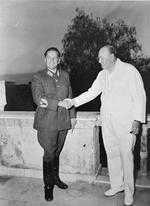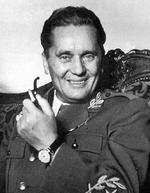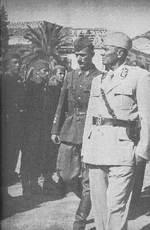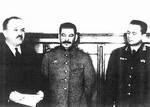Josip Tito
| Surname | Tito |
| Given Name | Josip |
| Born | 7 May 1892 |
| Died | 4 May 1980 |
| Country | Yugoslavia |
| Category | Military-Ground |
| Gender | Male |
Contributor: C. Peter Chen
ww2dbaseJosip Broz Tito was born Josip Broz in Kumrovec in the Austro-Hungarian Empire in present-day Croatia. His father was Croatian and his mother was Slovenian. He was not educated in his childhood. In 1907 he became a machinist's apprentice in Sisak, and three years later joined a metallurgy workers union, becoming politically active regarding labor issues. In the same year, he also joined the Social-Democratic Party of Croatia and Slavonia. During WW1, he was arrested for anti-war propaganda and sent to the Eastern Front to fight against Russia where he was captured by the Russians. He spent time in a work camp in the Ural Mountains where he continued to fight for workers' rights despite the fact that the workers were all prisoners of war. During the inter-war years, he continued the same aspirations and eventually enlisted in the Russian Army in Siberia and in 1918 joined the Russian Communist Party. As he gained the trust of Communist leadership, he was returned to Yugoslavia by his the Comintern in 1936, and by 1937 became secretary general of the Yugoslav Communist party. By this time, he was going by the name Tito which he is better known as today.
ww2dbaseYugoslavia was engulfed in WW2 during the German invasion of the Balkans, and the nation capitulated in Apr 1941. As chief of the military committee of the Yugoslav Communist Party, Tito led the Yugoslav communists in their resistance against the Axis occupation forces. Resistance began sporadically, but soon gathered momentum as Tito continued to call on the Yugoslavs to fight against Fascism. As Tito's men liberated territories from Axis control, he proclaimed himself the leader of a provisional Yugoslav government on 4 Dec 1943 and set policies for post-war Yugoslavia. These actions brought him negative attention from Berlin as he became one of the most wanted men of the German forces in the region, but at the same time it also gained rather favorable views from the western Allies. In after the Tehran Conference of Nov 1943, Tito's resistance group became the group the western Allies supported for the fight against Germany in Yugoslavia. The British organized the Balkan Air Force to support Tito's initiatives, though his close ties of Russia somewhat alarmed the western Allies. On 5 Apr 1945, he allowed Russian troops to enter Yugoslavia, which helped driving Axis forces out of Yugoslavia.
ww2dbaseAfter WW2, Tito remained in power as the leader of Democratic Federal Yugoslavia; in Nov 1945 he was named Prime Minister and the Minister of Foreign Affairs. He rounded up political enemies, including the leader of Četnik, Dragoljub Mihailović, who fought against the Axis occupation during the war as well. His men were also allegedly involved in the murder or deportation of ethnic Germans in Yugoslavia. Over the next few years Tito's policies drifted from that of Moscow, and on 28 Jun 1948 the Yugoslav Communist Party was detached from Russia. In 1950, he experimented with some limited elements of capitalism. As he assumed the role of President on 14 Jan 1953, he set into motion the reformation of the country into a socialist republic. The nation was officially renamed the Socialist Federal Republic of Yugoslavia on 7 Apr 1963. His brand of socialism was unique in Eastern Europe, and his people enjoyed a slightly higher standard of living in the region. The economic successes gave him the charisma to tie the country together despite episodes of ethnic and political tension. On 16 May 1974, a new constitution gave him the authority of the presidency for life.
ww2dbaseIn Jan 1980 Tito was admitted into a hospital for blood circulation problems in his legs. His left leg was eventually amputated. He passed away in the same hospital in May 1980. His death created a power vacuum, and the ethnic and political divides grew into war that lasted for many years.
ww2dbaseSource: Wikipedia.
Last Major Revision: Feb 2006
Photographs
 |  |  |  |
Josip Tito Timeline
| 7 May 1892 | Josip Broz was born in Kumrovec, Kingdom of Croatia-Slavonia, Austria-Hungary. |
| 27 Jun 1941 | The Central Committee of the Communist Party of Yugoslavia appointed Tito as Commander-in-Chief of the Yugoslavian Peoples Army. |
| 9 Jun 1943 | Tito was wounded by a German air attack. |
| 21 Jul 1943 | The German authorities in Belgrade, Yugoslavia offered a massive reward for the betrayal and capture of Yugoslav partisan leader, Tito. |
| 22 Dec 1943 | Allies designated Tito as the Allied commander in Yugoslavia. |
| 26 Mar 1944 | British Prime Minister Winston Churchill praised Yugoslavian partisans under Tito. |
| 21 Sep 1944 | Josip Broz Tito arrived in Romania. |
| 4 Dec 1944 | The US publication Time reported that Tito had announced a provisional socialist Yugoslavian government from Moscow, Russia. |
| 18 May 1945 | Marshal Tito, in negotiations with British and US representatives over disputed territory, claimed to have the right to add Trieste to Yugoslav territory, and refused to leave the area. |
| 11 Nov 1945 | Tito was elected the first prime minister of the soon-to-be-established Federal People's Republic of Yugoslavia. |
| 29 Nov 1945 | The Federal People's Republic of Yugoslavia was declared, with Ivan Ribar as the first president (to be made official in the following month) and Josip Broz Tito as the first prime minister. |
| 4 May 1980 | Josip Tito passed away in Ljubljana, Slovenia, Yugoslavia. |
Please consider supporting us on Patreon. Even $1 per month will go a long way! Thank you. Please help us spread the word: Stay updated with WW2DB: |
Visitor Submitted Comments
17 Jan 2011 11:24:50 AM
ahh, this is fake guys, go to a different website?!
3 Feb 2011 09:48:02 AM
this site is horrible!!!!!!
8 May 2018 03:44:01 PM
This post has many inaccuracies. The greatest is that Četnik fought against Axis forces. After 6 mounth they shifted a side and fought along side German, Italian...!!
All visitor submitted comments are opinions of those making the submissions and do not reflect views of WW2DB.
- » US Government Plans to Purge WW2 Information (17 Mar 2025)
- » WW2DB's 20th Anniversary (29 Dec 2024)
- » Wreck of USS Edsall Found (14 Nov 2024)
- » See all news
- » 1,167 biographies
- » 337 events
- » 44,601 timeline entries
- » 1,243 ships
- » 350 aircraft models
- » 207 vehicle models
- » 376 weapon models
- » 123 historical documents
- » 261 facilities
- » 470 book reviews
- » 28,520 photos
- » 367 maps
Thomas Dodd, late 1945
Please consider supporting us on Patreon. Even $1 a month will go a long way. Thank you!
Or, please support us by purchasing some WW2DB merchandise at TeeSpring, Thank you!
14 Sep 2010 09:11:06 AM
what was his wife's name and what was she lie???????